
A resident greets us in Saint-Rémy, Provence
After forty fast-paced days touring Spain, we arrived in Provence looking forward to a relaxing, week-long stay in an apartment in Saint-Rémy. We rolled into town in a rental car, dutifully turning when the GPS instructed. On the right hand side of the street we quickly spotted the building where we would be staying. Then, on the left, we looked for the plentiful parking spaces we were told were there—except that the five spots were entirely full, as they would be every day while we were there.
We had no choice but to keep going forward along the one-way street, directly into the town’s tiny, twisting medieval section. With memories of harrowing drives in Spanish hill towns still front of mind, Brian deftly dodged pedestrians and navigated tight turns. I was clutching the passenger side door, hoping to make it back to a main street without mishap, which we eventually did. After that nerve-racking introduction to Saint-Rémy, we promptly parked the car and used it only for day trips around the area.
Situated at the foot of the Alpilles mountain range, this beautiful Provençal town is bathed in sunlight 300 days of the year. There are restaurants, shops, and art galleries galore, but predictably, it was Saint-Rémy’s historic sites and traditions that drew our interest.
Collégiale Saint-Martin
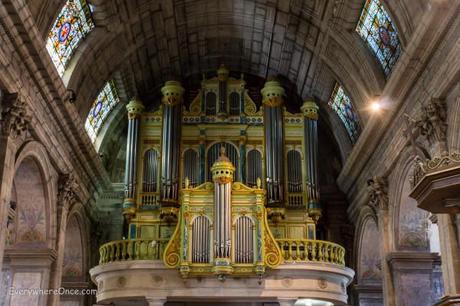
We both heard and saw Saint-Rémy’s cathedral, Collégiale Saint-Martin. In the evenings, the tolling of the church’s bells brought talk to a halt. The melodic sound came from almost directly above us—we could see the cathedral bell tower through the skylight in our apartment rental. The church’s interior was a conversation stopper, too. It’s hard to say which was more captivating: original 16th-century frescoes or the beautifully decorated pipe organ.
Souvenir Shopping
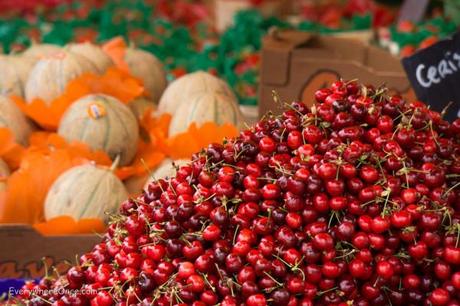
Market days are a long-held tradition in Provence. To get to the one in Saint-Rémy was as easy as opening the front door of our building. On Wednesday mornings the streets and plazas in the city’s old town are transformed into a shopper’s mecca. Luckily for us, there were all sorts of edibles for sale. Traveling with backpacks curbs the desire to shop since there simply isn’t space to carry anything additional. But if we can eat it or drink it, it’s fair game—like the bright-pink, raspberry macarons and chewy, cherry nougat we enjoyed.
Admiring Van Gogh’s Views
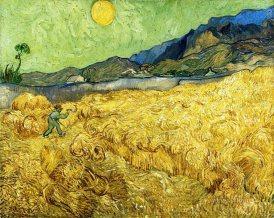
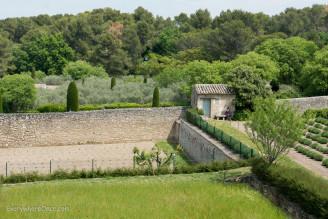
View from Van Gogh’s Saint Remy asylum window
Saint-Rémy was a creative hot spot for Vincent Van Gogh. In 1889, not long after cutting off part of his left ear in a fit of despair after a fight with painter Gaugin, he voluntarily checked himself into the Monastery of Saint Paul de Mausole, an asylum in the hills above the town. He spent most of the last year of his life here and produced an impressive 150 paintings, including the famed Starry Night.
The Van Gogh connection was one reason we decided to stay in Saint-Rémy, inspired in part by seeing Starry Night at New York City’s Museum of Modern Art just days before leaving for Europe. Both Saint-Rémy and Arles, the bigger and more famous Provençal town associated with the artist, tout self-guided walks leading to places he depicted on canvas.
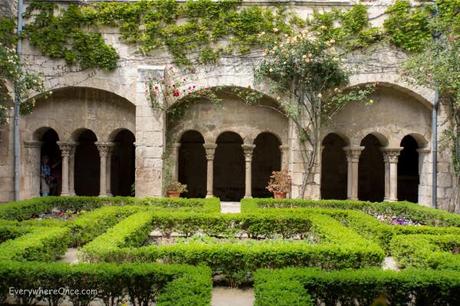
Monastery of Saint Paul de Mausole cloisters
Of the two towns, we found more shades of Van Gogh in Saint-Rémy. It’s less developed than Arles, particularly the area surrounding Saint Paul de Mausole. Van Gogh was initially confined to the immediate asylum grounds, painting scenes he saw from his room’s window and inside the walled garden. He was later allowed to venture further afield, capturing on canvas the olive groves and cypress trees that still thrive there. Signboards posted along the route correspond to Van Gogh’s works.
The tranquil 12th-century Saint Paul de Mausole, today a sanatorium for women where art is used as therapy, is worth a stop. Along with seeing a recreation of Van Gogh’s rooms, a sleeping chamber and an adjoining studio, visitors can stroll through the garden, the cloisters, and a Romanesque chapel.
Exploring Roman Ruins
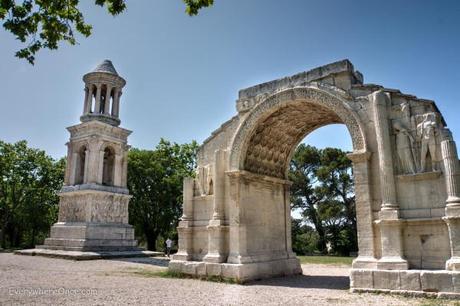
Van Gogh never saw the ancient ruins at Glanum. The remains of the Roman town, a short stroll from Saint Paul de Mausole, hadn’t been unearthed when the artist lived in Saint-Rémy. Although a few artifacts were found in the 18th century, excavation didn’t begin until the early 1920s.
Glanum was first settled by the Celts in the Iron Age before being taken over by the Greeks and then the Romans, who built a thriving city here. Among its monuments is a triumphal arch from the time of Julius Caesar. Dating to 20 B.C., it’s the oldest in Provence and stands right on the side of the main road leading into Saint-Remy.
The best part about Glanum, one of France’s major classical sites, is that we didn’t have to get behind the wheel to step back in time. The Roman ruins are within walking distance of Saint-Rémy’s town center.

